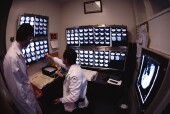- Understanding the Connection Between Anxiety and Depression
- How Daily Prunes Can Influence Cholesterol and Inflammation
- When to Take B12 for Better Absorption and Energy
- Epsom Salts: Health Benefits and Uses
- See What Saffron Can Do for Sleep and Heart Health
- 6 Common Mistakes to Avoid Before Your Physical
- Can Sweating Really Help You Beat a Cold?
- Strengthening Your Relationship: Practical Strategies
- Skip Storing This Everyday Product in the Fridge Door
- Green Tea + B3 Pairing May Boost Brain Health
Scientists Find New Way to Observe ‘Good’ Brown Fat


In a possible advance for obesity research, an MRI scan has pinpointed “good” brown fat in a living adult for the first time.
The researchers say their success could help efforts to fight obesity and diabetes.
Unlike white fat, brown fat is considered good because it burns calories and helps control weight. Learning more about brown fat could lead to new ways to improve people’s health, the scientists said.
“This is an exciting area of study that requires further research and discovery,” study author Dr. Thomas Barber, at the University of Warwick Medical School, in Great Britain, said in a university news release.
“The potential is there for us to develop safe and effective ways of activating this brown fat to promote weight loss and increase energy expenditure — but we need more data to be able to get to that point,” Barber said.
The first successful use of MRI to detect brown fat in living adults is important because “it allows us to pursue MRI techniques in future assessments and gather this required information,” he explained.
Currently, positron emission tomography (PET scan) is used to detect brown fat, but can only do so when the fat is “active.” MRI can detect brown fat whether it’s active or not, thereby providing a more complete picture of where it is found in the body, the study authors said.
This information could assist efforts to develop treatments meant to activate brown fat deposits, according to the authors of the study in the current issue of the Journal of Clinical Endocrinology and Metabolism.
“The MRI allows us to distinguish between the brown fat and the more well-known white fat that people associate with weight gain, due to the different water-to-fat ratio of the two tissue types. We can use the scans to highlight what we term ‘regions of interest’ that can help us to build a picture of where the brown fat is located,” Barber said.
The next step in this research is to confirm MRI’s ability to detect brown fat in a larger group of adults.
More information
The U.S. National Institutes of Health has more about brown fat.
Source: HealthDay
Copyright © 2026 HealthDay. All rights reserved.










